
In the digital era in which we live, technology continues to advance in an impressive way, and communication is no exception. Until recently, it seemed impossible to communicate without words, but technology has proven otherwise.
A new technology has been developed that makes it possible to communicate without words, using smart glasses. These glasses are able to interpret facial movements and eye expressions, allowing them to translate them into sentences and words that can be sent over an Internet connection.
This new development is a major step forward in the way we communicate. The smart glasses are capable of interpreting a wide range of facial and eye expressions, meaning they can be used by a wide variety of people, including those who have difficulty speaking, as well as those who are in noisy environments or are unable to speak due to a disability.
Instead of relying on sign language or an interpreter, people wearing these glasses can communicate directly with others without having to worry about a language barrier or cultural differences.
The technology behind these glasses is impressive. They use a combination of artificial intelligence and machine learning to interpret facial movements and eye expressions, and then translate them into sentences and words. The technology has advanced so far that these glasses can even learn the wearer’s communication patterns and preferences, allowing them to deliver a personalized communication experience.
Although smart glasses are still a relatively new technology, they have already proven useful in a variety of situations. For example, workers in the customer service industry can use these glasses to communicate with customers in noisy environments, while doctors can use them to communicate with patients who have difficulty speaking or hearing.
How the non-speaking glasses work
Glasses that allow you to speak without speaking are a new technology that uses artificial intelligence and machine learning to interpret facial and eye expressions and then translate them into sentences and words. These glasses are able to detect a wide range of facial and eye expressions, allowing them to translate them into understandable language.
The operation of these glasses is very interesting. They are based on a set of sensors and cameras integrated into the glasses, which collect data on the user’s facial movements and eye expressions. This data is processed by an artificial intelligence algorithm that has been trained to identify specific patterns of facial and eye movements.
Once the data has been collected, the artificial intelligence algorithm processes the data and translates it into phrases and words. These phrases and words are displayed on a screen integrated into the glasses, which allows the user to read what has been translated.
The most impressive thing about these glasses is that they can adapt and learn the user’s communication patterns and preferences. As the glasses are worn, the artificial intelligence algorithm collects data and learns to interpret the user’s facial and eye expressions in a more accurate and personalized way.
Glasses that allow speech without speech are very useful for people with speech or hearing disabilities, as well as for people in noisy environments or with language barriers. They are also useful in situations where discreet communication is required, such as in business or legal environments.
How do these glasses change the way we communicate?
Glasses that enable nonverbal communication have the potential to revolutionize the way we communicate. Here are some of the changes these glasses can bring:
Greater inclusion: these glasses allow people with speech or hearing disabilities to communicate more effectively and participate in conversation. They can also help overcome language barriers, meaning people from different countries or cultures can communicate more easily.
Discreet communication: In some situations, it may be necessary to communicate discreetly, such as in business or legal environments. Glasses that enable nonverbal communication can allow people to communicate without having to speak out loud.
Increased efficiency: Glasses that enable nonverbal communication can speed up communication by eliminating the need to wait for someone to finish speaking or repeat something several times. This can make communication more efficient and faster.
Machine learning: Glasses that enable nonverbal communication can adapt to the wearer’s communication patterns and preferences. As the glasses are worn, the artificial intelligence algorithm collects data and learns to interpret the wearer’s facial and eye expressions in a more accurate and personalized way.
Benefits and potential applications of speech-enabled glasses for nonverbal communication
Glasses that enable nonverbal communication have the potential to have a wide variety of benefits and applications in different areas. Some of these include:
Benefits for people with disabilities: These glasses can enable people with speech or hearing disabilities to communicate more effectively and participate more fully in everyday life. They can also improve the quality of life for people with disabilities by helping them communicate more easily with loved ones, friends and caregivers.
Improvements in education: Glasses that enable nonverbal communication can be a valuable tool for teachers and students. For example, teachers can use the glasses to better understand students’ facial expressions and adjust their teaching accordingly. Students can also use the glasses to communicate with each other in the classroom, which could improve collaboration and teamwork.
Help in emergency situations: Glasses that enable nonverbal communication can be useful in emergency situations, such as in hospitals, where people may be unable to speak or hear due to injury or illness. The glasses may enable doctors and nurses to communicate with patients more effectively, which could improve the quality of medical care.
Improved communication in the workplace: Glasses that enable nonverbal communication can also be useful in the work environment. For example, in jobs where communication is required in noisy environments, such as factories, glasses can allow workers to communicate without having to raise their voices.
Help in social situations: Glasses that enable nonverbal communication can help people in social situations, such as appointments or business meetings, where it is important to communicate effectively but discreetly. The glasses can allow people to communicate without having to speak loudly or make exaggerated gestures.
Interview with the inventors of glasses that enable nonverbal communication
Interviewer: Hi, thank you for speaking with me today, could you please introduce yourselves and tell us a little bit about your experience in developing communication technologies?
Inventor 1: Hi, I’m John and I’m one of the inventors of these glasses. I have a background in electronics and communication technology.
Inventor 2: And I’m Sarah, I’m also an inventor of these glasses. I have a background in product design and wearable technology.
Interviewer: Cool! So can you tell us how you came up with the idea of developing these glasses that enable nonverbal communication?
Sarah: The idea came about a few years ago when we were working on a wearable technology project. We realized that many people with speech and hearing disabilities have difficulty communicating effectively, especially in social situations.
John: Yes, and as engineers, we knew we could use technology to solve this problem. We researched and experimented with different sensors and devices until we finally came up with this glasses technology that enables nonverbal communication.
Interviewer: That’s awesome, can you tell us a little bit about how these glasses work?
John: Absolutely. The glasses have a camera that captures the user’s facial expressions and software that interprets them in real time. They also have a built-in speaker and microphone so the wearer can listen and respond to conversations.
Sarah: And most importantly, the glasses are designed to be user-friendly and portable, which means people can wear them anywhere, anytime.
Interviewer: So how do you see these glasses potentially changing the way we communicate?
John: I think these glasses have the potential to improve the quality of life for many people who would otherwise have difficulty communicating effectively. They can help people with speech and hearing disabilities participate more fully in everyday life and improve the quality of medical care in emergency situations.
Sarah: I also believe that these glasses can improve collaboration and teamwork in educational and work environments. People can communicate more effectively in noisy environments or in situations where speaking out loud is not possible.
Interviewer: That’s really exciting! What are your plans for the future of this technology?
John: We are working on continued improvements to the technology, including integrating more languages and dialects, as well as developing additional technologies that enable nonverbal communication.
Sarah: We’re also exploring different ways to collaborate with companies and organizations to make sure that these glasses are accessible to everyone who can benefit from them.
Interviewer: Well, thank you for talking with me today. It’s exciting to see how technology can improve the quality of people’s lives and make communication more accessible and effective for everyone.
Are glasses that allow you to speak without words an invasion of privacy?
The answer to this question depends on how the glasses are used and how the information obtained through them is collected and used. Like any recording technology, glasses that enable nonverbal communication can raise privacy concerns if used inappropriately.
For example, if the glasses are used to record people without their knowledge or consent, that could be an invasion of their privacy. Similarly, if the information collected through the glasses is used inappropriately, such as for surveillance purposes or to collect personal data for commercial purposes, that could also be a privacy issue.
However, if the glasses are used in an ethical and transparent manner, with the consent of all parties involved, and the privacy of the individuals wearing them is protected, then they are not necessarily an invasion of privacy. In many cases, glasses that enable nonverbal communication can improve the quality of life for people with speech and hearing disabilities, as well as those who work in noisy environments or in situations where it is difficult to speak out loud. As with any technology, it is important to consider the ethical and privacy implications of using these glasses and to ensure that they are used responsibly.







